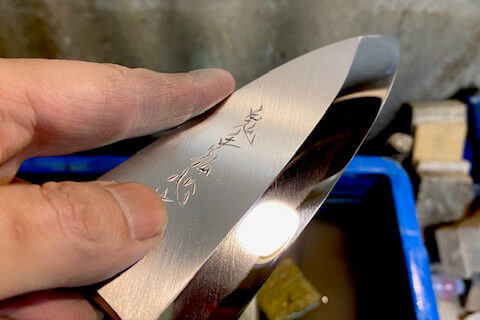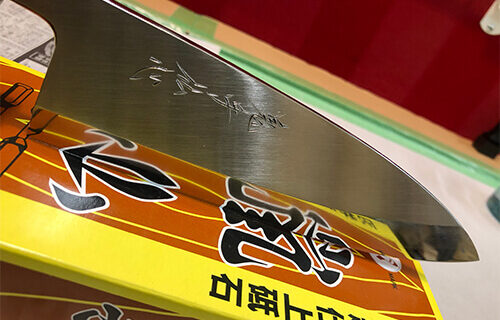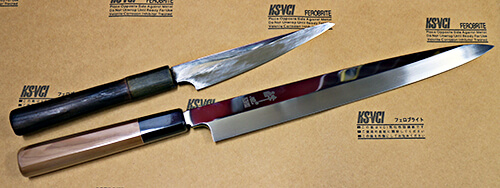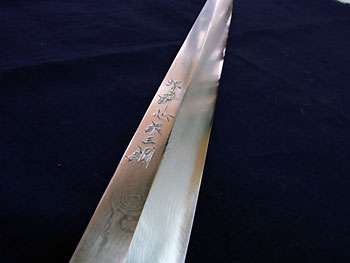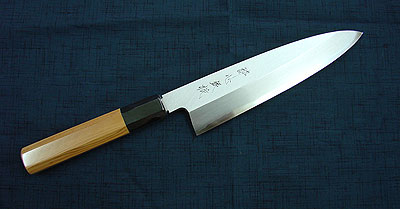Initial lot SUISIN HAYATE

One of the initial lots of the HAYATE series, which Suisin started working with Keijiro Doi, has returned in the form of a repair.
It was manufactured in 2002 and has been used on site for 16 years.
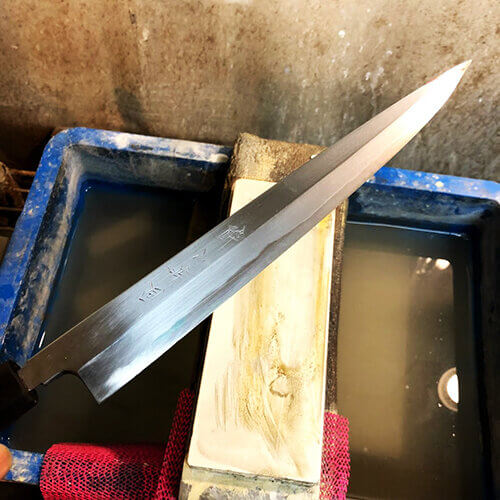
At that time, it was sold as a 270mm Yanagiba, but the size of the kitchen knife that came back was 240mm.
The sharpening made it shorter, and the shape of the tip also changed. The owner has carefully polished it, and it is in very good condition with no rust.
After 16 years of use, it tends to become a “crane neck(鶴首)” when the tip is not sharpened well.
However, the owner doesn’t do that, and seems to have been using it so that it doesn’t become a “crane neck” by sharpening it with the tip raised to the peak side.
The request was not about sharpening. However, I had a sentimental attachment to this knife and ended up wanting to sharpen it. So, I asked the customer, “Could I sharpen it and give it a refresh?”
The customer kindly agreed, so I started sharpening immediately.
Here is what it looks like after polishing.

I judged that the cutting edge that was raised to the peak side would not work well on the ingredients. This is resolved by sharpening from the peak side. The disadvantages that occur by doing it will be adjusted carefully and carefully. To be specific about one thing, I raised the Shinogi because the cutting edge of the tip became narrow. I wanted to raise it more, but I didn’t want to force a reduction, and I kept it at a minimum necessary level, considering the customer’s future sharpening needs.
This is a good knife that is tightly-packed and has a firm feel. The whetstone rides well and the knife is easy to sharpen.
The characteristics of the kitchen knife made by Mr. Keijiro Doi were clearly identifiable.
This knife embodies the desire that Mr.Keijiro had expressed, “I want to make a knife like this!”

As expected, it had been used for 16 years, so the back blade had spread. In order to correct this, it is necessary to ask a blade grinder to retake the ratio of the back side. In that case, knife will be asked to go through the same process as sharpening a new knife using a large circular whetstone. If you want to completely correct the shape of the knife, this part also needs adjustment. However, the stamp on the back will disappear, and the steel will decrease! ! I decided it was best to use it as is.
Long-cutting knives require less sharpening. If you sharpen it with a finishing whetstone before it becomes completely uncut, it will regain its sharpness. If you sharpen it after it becomes dull, there are many disadvantages.
1.time consuming.
2.Knife wears out quickly.
3.It loses its shape
etc…
Good knives, starting with HAYATE, cost a certain amount of money, but isn’t it worth more than that?
hibishugyo 2018-09-13
SUISIN HAYATE[酔心疾風]
The text below is the comment I received when I wrote this article. Please understand that there are many expressions that are peculiar to Japanese, so there are some parts that cannot be translated well.
No title
No title
good job for today. It’s been 16 years, but it’s amazing how beautiful it is. I’m sure Keijiro would be very pleased.
As a reader, I am happy to read this article. SUISIN HAYATE keeps cutting for a long time, so I feel like I can keep using it for 10 or 20 years.
Re: No title
Dere わんきち
Well, Mr. Keijiro Doi’s knives are exquisite in the softness of soft iron and the hardness of steel. Beautiful contrast comes out automatically. For the whetstone, we used “Kitayama” for the steel part and “Our #10000” for the kasumi part.
Re:No title
Dere ゆうじ
Well, after 16 years, it is often seen that the rust has deepened and the shape has collapsed. Looking at the knives that are handled so beautifully, you can tell that they are taking good care of them. Looking at the kitchen knife, you can imagine how the person cooks. The narrower the back push, the sharper the edge as a single edge. However, if the back blade is as wide as this knife, I think it can be used for a wide range of purposes. It is said that strength comes out, or that the blade is born with stiffness …
